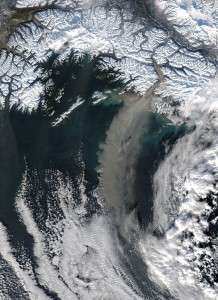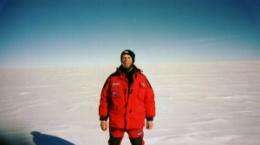What dust may have to do with Earth's rapidly warming poles

(Phys.org)—As earth's climate warms, scientists have tried to understand why the poles are heating up two to three times faster than the rest of the planet. Airborne dust, it turns out, may play a key role.
In a new study in Nature Climate Change, researchers show that at the peak of the last ice age, some 21,000 years ago, the poles were 10 times dustier than today, while areas closer to the equator had twice as much dust. During this time of extreme cold, New York City was under two miles of ice and up to 12 degrees F colder than today while Greenland was about 45 degrees F colder. The study's authors suggest that higher atmospheric dust concentrations at the poles during the last ice age helped to cool earth's surface and prevent snow and sea ice from melting during summer.

Strong winds sweep dust containing tiny mineral particles from the ground and into the air, across continents and oceans. In the atmosphere, dust influences climate by reflecting and absorbing sunlight, influencing cloud formation and seeding the oceans with nutrients that allow microscopic plants to grow. In today's world, the poles have relatively little dust. Scientists are unsure why the polar regions were so much dustier during glacial periods than interglacials like today, but stronger winds and changes in atmospheric circulation and precipitation patterns probably played a major role.
Climate modelers have struggled to reproduce the extreme cooling that took place at the poles compared to the rest of the planet during the last ice age, casting doubt on the accuracy of their forecasts. "This failure makes it hard for climate models to accurately predict how much warmer the poles will get in the future," said the study's lead author, Fabrice Lambert, a climate scientist at Korea Institute of Ocean Science and Technology. "We find that the models underestimate glacial polar dust concentrations as well."
Today, temperatures are rising rapidly as humans put large amounts of heat trapping gases such as carbon dioxide and methane into the air. Could dust help to cool things off? Some scientists think that the future could be dustier as climate change, the razing of forests and over pumping of ground water create more deserts. In Asia and Africa, a doubling of dust emissions in some regions over pre-industrial levels has already occurred. At the same time, increases in soot and other industrial atmospheric particles that warm the climate could more than offset any dust-related cooling.
"Humans are changing the planet in so many ways that it's hard to say how it all will influence climate in the end," said study coauthor Gisela Winckler, a geochemist at Lamont-Doherty. "We know that dust and other atmospheric particles are an important piece of the puzzle, and that more observations from the past can help us better understand what will happen in the future."
More information: www.nature.com/nclimate/journa … ll/nclimate1785.html
Journal information: Nature Climate Change
Provided by Columbia University




















